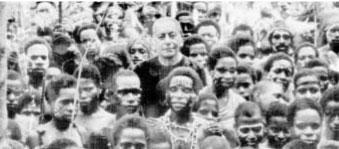|
Allan Gurganus: Your apartment here is laden with "Ancestor Skulls," skulls given to you by your loving adoptive families in New Guinea. You could do Hamlet’s "Alas, poor Yorick" in any corner of your house and with real human ivory! How does it feel, living with the bones of loved ones in plain view? You’ve told me that in the jungle these skulls are used as pillows for the living – hence the beautiful sheen that human contact, human oils, awards. Can you imagine living with the skulls of your late and actual father, mother and brother in the same way? Do you wish to have those here? How does the New Guineans’ sense of human remains as treasure compare with the Western aversion to the bodily, even when alive?
Tobias Schneebaum: The skulls in my apartment keep me in touch with my ancestors. Through them, I absorb the essence of their beliefs. Through them I gain their strength. The skulls were given to me by families that had adopted me. They were given to me over the course of many transactions, a skull for a steel axe, or, they were given to me with no apparent strings attached, nothing but friendship. The skulls now sit on shelves in one of my bookcases. They look out in all directions, viewing the Hudson River, trying to prepare themselves for whatever might be ahead. They exude an energy familiar to me. They somehow reach out and stretch their invisible muscles to touch my silence with their memories. When I open the door, I feel their breath. Their presence protects me, watches over me. I am more aware of dreaming when surrounded by my ancestors. More often than not, I remember simply that there
were dreams.
One rainy day, I watched a child rolling one of the skulls on the rough flooring of the family house. It was as if he were in a bowling alley. The relationship between the boy and the ball was a warm and affectionate one. There was no fear of the dead, no horror, no disgust. Only comfort. When death comes in Asmat, the body is wrapped in a mat made of pandanus leaves and placed on a platform six feet above the ground. The body is then left there with young boys to protect it from the dogs, until the maggots have cleaned all the flesh from the skull. Normally, the skull would then be inherited by the oldest son or daughter.
I cannot imagine the skull of one of my blood relatives in New York sitting on a shelf. It is ludicrous. It would have no connection with anything else there. Perhaps if I kept such a skull around for years I would eventually become accustomed to its presence and even enjoy having it here, who knows?
-- Bomb magazine

|